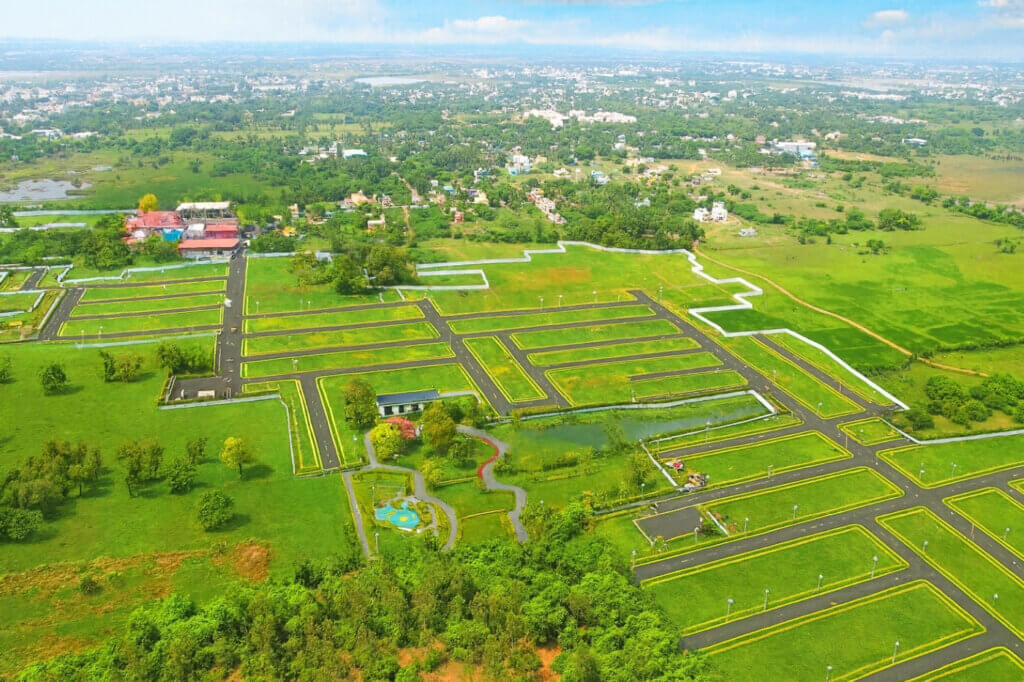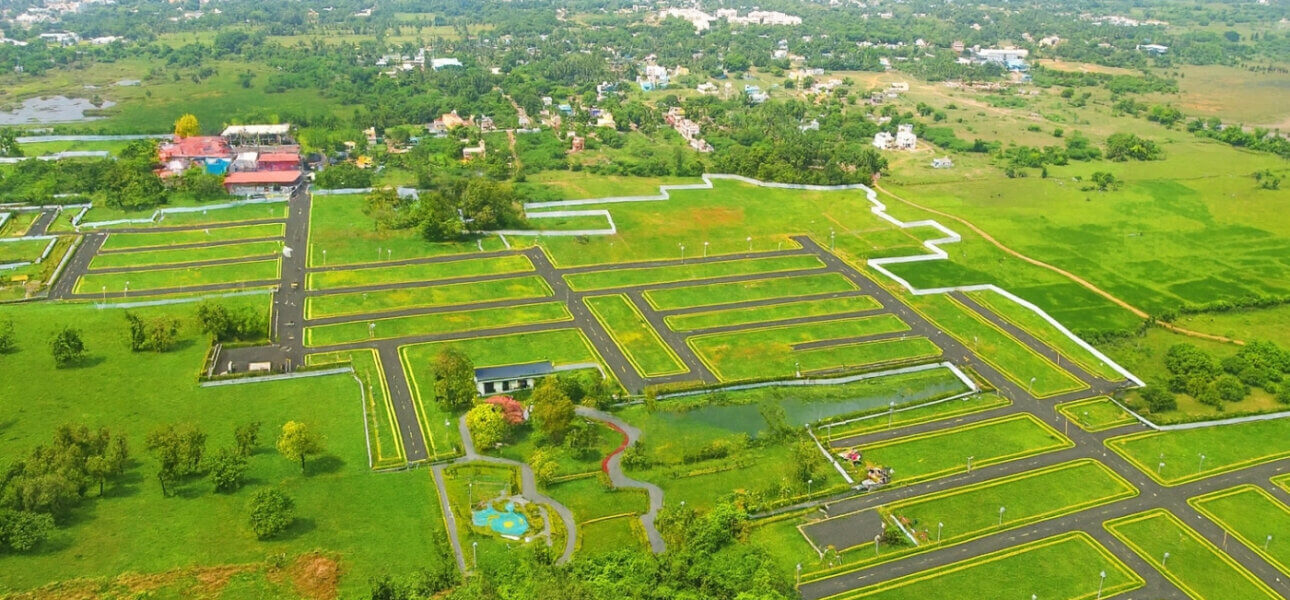A rain garden turns monsoon showers into a steady water supply for your landscape. It slows runoff, filters pollutants, and adds lush greenery that stays fresh even in peak summer. If you are planning a sustainable home in Padappai, a smartly designed rain garden can be your low-maintenance hero.

What is a rain garden and why it suits Padappai
A rain garden is a shallow landscaped basin that captures roof and driveway runoff, letting water soak into the soil within a day. In Chennai’s climate, short intense rains are common. Padappai and the Oragadam belt see quick surface runoff from tiled roofs and paved areas. A rain garden helps you:
- Recharge groundwater for your borewell
- Reduce water logging near the house
- Keep the site tidy by directing overflow to a safe point
- Grow hardy, beautiful native plants with less irrigation
Tip: Place the garden at least 3 metres away from the plinth to protect foundations.
Quick site check before you start
- Slope: Ideal is a gentle fall from structures toward the garden location.
- Soak test: Dig a 30 cm hole, fill with water, and see if it drains within 24 hours. If slower, plan for deeper sand in the mix or create a second cell.
- Utilities: Mark underground lines before excavation.
- Catchment: Map roof gutters, downpipes, and driveway flow.
Ideal size and depth for villa plots
For most 1000 to 2400 sq ft plots, a basin of 3 to 6 percent of the roof area is a good start. Depth can be 15 to 25 cm with gently sloped sides. For larger villas or corner plots, use two smaller linked basins rather than one big pit. This looks better and drains faster.
Two-cell layout that works
- Cell 1 near the downpipe with a rock forebay to catch silt
- A shallow spillway lined with flat stones
- Cell 2 as the main planting bed with mixed soil layers
The winning soil recipe
Padappai soils vary from red loam to clayey patches. A workable mix is:
- 40 percent coarse sand for infiltration
- 40 percent screened topsoil
- 20 percent compost
Add a 5 to 8 cm mulch layer on top. In very clayey corners, add a gravel underlayer of 10 to 15 cm to prevent water sitting.
Plants that thrive in rain gardens
Choose species that handle wet feet during rain and dry spells later. Blend structure, colour, and pollinator value.
Grasses and strappy forms
- Vetiver
- Lemon grass
- Fountain grass
- Cyperus varieties around the deepest part
Flowering natives and hardy perennials
- Hibiscus rosa-sinensis for edges
- Canna indica for bold foliage
- Crinum lilies and rain lilies that burst after showers
- Wedelia for quick ground cover
- Ruellia and periwinkle for colour
Shrubs and small trees for the berm
- Plumeria near the drier rim
- Ixora along the sunny side
- Guava or drumstick for edible interest on the berm
Group plants in repeating clumps for a landscape look rather than a scattered feel.
Directing water in neatly
- Fit leaf guards on gutters to reduce debris
- Use a downpipe with a simple first-flush diverter
- Lay a short rill with pebbles or recycled pavers to slow the inflow
- Add a perforated splash rock zone where water first lands
Overflow and safety
Always plan a safe exit for extreme rain. A shallow turf swale leading to a roadside drain or a percolation pit is enough for most villa plots. Keep the basin depth modest and edges rounded for child safety. Avoid still water beyond 24 hours to discourage mosquitoes.
Low-maintenance routine
- Remove silt from the forebay once every season
- Top up mulch before the northeast monsoon in October
- Trim grasses after flowering to keep form tight
- Replace any plant that struggles rather than forcing it
- Refresh compost lightly in February for summer resilience
Aesthetic ideas that elevate your garden
- Stepping stone arc across the shallowest side so you can walk through after rain
- Contrast mulch with dark bark on the rim and lighter pebble in the forebay
- Lighting with low solar bollards along the berm for evening sparkle
- Feature boulder or driftwood at the inlet for a crafted, natural cue
- Butterfly strip with pentas and lantana on the drier edge to invite pollinators
Integrating with your villa design
- Align the rain garden with a front court or sit-out view so it becomes a focal feature
- Pair it with a narrow herb strip on the berm for kitchen use
- Use the same stone or paver from your pathway at the spillway for visual continuity
- If you plan a car porch, capture its runoff separately into a small side cell
Cost-smart tips for first-time owners
- Upcycle broken pavers as inlet riprap
- Source compost from a neighbourhood vendor and mix onsite
- Start with hardy, fast growers like canna, wedelia, and vetiver, then add premium ornamentals later
- Share plant divisions with neighbours to build community green cover
Why this matters for sustainable homes in Padappai
Water security is a top concern for every household. A well-designed rain garden reduces tanker dependence, supports a cooler microclimate, and adds biodiversity. In a community like Velammal Garden, multiple homes adopting rain gardens can enhance overall stormwater management and make streets greener and safer. Learn more about the community vision at velammalgarden.com and explore plot planning ideas tailored to Padappai’s climate at velammalgarden.com.
Simple step-by-step plan
- Sketch your roof and driveway runoff map
- Pick a low point at least 3 metres from the house
- Mark two basins and a shallow connecting spillway
- Excavate 15 to 25 cm, loosen the subsoil
- Add gravel if clay is heavy, then the soil mix
- Shape gentle side slopes, add mulch
- Plant in clumps, water well, and test during the first rain
- Maintain the forebay and refresh mulch before each monsoon
Mini checklist for approvals and good practice
- Keep drains unblocked at the plot boundary
- Do not connect overflow into septic lines
- Maintain clear setbacks as per approvals
- Use non-slip stones at the inlet path
FAQs
What is the main purpose of a rain garden in villa plots
A rain garden captures and filters roof and driveway runoff, recharging groundwater and reducing flood risk. It is a practical way to build a sustainable home in Padappai without complex systems.
How big should my rain garden be for a 1000 sq ft roof
Aim for 3 to 6 percent of roof area. For a 1000 sq ft roof, a 30 to 60 sq ft basin at 15 to 25 cm depth is adequate, split into two cells if space allows.
Which plants are best for rain garden ideas for villa plots in Chennai
Use vetiver, canna, rain lilies, wedelia, hibiscus, and ixora. Place moisture-loving species in the centre and tougher shrubs on the berm for all-season performance.
Will a rain garden attract mosquitoes
No, if designed correctly. The basin should drain within 24 hours. Mulch the surface, avoid standing water, and keep the inlet clear so flow remains steady.
Can I combine a rain garden with a kitchen garden
Yes. Keep vegetables on the higher, drier berm while the centre handles runoff. Use overflow to feed a small percolation pit that keeps your irrigation needs low in summer.
Designing with water in mind is not just eco-friendly, it is a lifestyle upgrade. With these rain garden ideas for villa plots, you can turn every shower into beauty and value for your home in Padappai.


